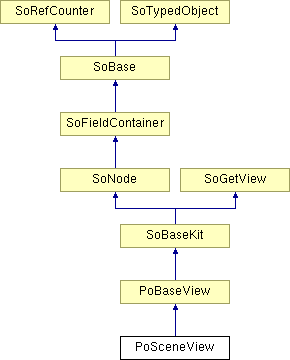PoSceneView Class Reference
[Views]
 Class to define a view which contains a scene.
More...
Class to define a view which contains a scene.
More...
#include <Inventor/Gui/view/PoSceneView.h>

Public Member Functions | |
| virtual SoType | getTypeId () const |
| virtual const SoNodekitCatalog * | getNodekitCatalog () const |
| PoSceneView () | |
Static Public Member Functions | |
| static SoType | getClassTypeId () |
| static const SoNodekitCatalog * | getClassNodekitCatalog () |
Public Attributes | |
| SoSFBool | isBackgroundVisible |
| SoSFBool | isBorderVisible |
Detailed Description
 Class to define a view which contains a scene.
Class to define a view which contains a scene.
This class allows the user to define a view which contains a scene.
Views allow the application to specify multiple cameras, each with its own separate viewport (region of the 3D window). This is more powerful than just using multiple SoCamera nodes, because camera nodes do not allow specifying a viewport (the viewport is always the full window). See PoBaseView for more explanation.
A scene is a set of any nodes (except SoCamera nodes) placed under an SoGroup node which must be seen in a viewport according to a camera configuration. To define a view, set the fields viewportOrigin and viewportSize according to the viewport position and size you want to have (relative to the display window sizes), configure the camera (set the part cameraKit), build the scene under an SoGroup node, and set this scene to the view (set the part scene). All shape nodes contained in the scene will be drawn in the viewport previously defined and according to the camera definition. You can define as many views as you want.
NOTES:
- If you use a viewer, you should call the method SoBaseKit::setSearchingChildren(TRUE) to allow the viewer to search for cameras inside nodekits (like this one).
- Do not place a camera node before this nodekit.
- Create a camera for each view and set it using the setPart method. See example.
- When you use HardCopy, the graphics window is the paper sheet.
LIMITATIONS:
- The field SoCamera::viewportMapping must be equal to ADJUST_CAMERA in order to have a correct vectorisation when you use HardCopy,
- Do not use the SoBoxHighlightRenderAction class on a scene graph which contains a view,
- Do not push view,
- Be careful when you use the method viewAll() of the class SoXtViewer, because this method works on the entire scene graph and not on a portion of a scene graph. Overload this method according to your requirements,
- Some of the viewer functions/buttons do not work correctly with views.
For example, saveHomePosition() and resetToHomePosition() do not work correctly because the viewer only stores one copy of the camera. - The viewer rendering options, e.g. wireframe, apply to ALL views inside the viewer. You can implement these effects per-view using an SoDrawStyle node and setOverride() if necessary.
- Views are not compatible with the VRML file format.
EXAMPLE
// Must enable this option or viewer will not be able to find the camera in the PoSceneView nodeKit. SoBaseKit::setSearchingChildren( TRUE ); // First scene graph SoSeparator* scene1 = new SoSeparator(); scene1->addChild( new SoCone() ); // First view (lower left corner of window) PoSceneView* view1 = new PoSceneView(); view1->sensitiveOnEvents( TRUE ); view1->isBorderVisible.setValue( TRUE ); view1->viewportOrigin.setValue( 0, 0 ); view1->viewportSize.setValue( 0.5f, 0.5f ); SoPerspectiveCamera* cam1 = new SoPerspectiveCamera(); view1->setPart( "cameraKit.camera", cam1 ); view1->setPart( "scene", scene1 ); cam1->viewAll( scene1, SbViewportRegion(100, 100) ); root->addChild( view1 ); // Second scene graph SoSeparator* scene2 = new SoSeparator(); scene2->addChild( new SoCube() ); // Second view (upper right quadrant of window) PoSceneView* view2 = new PoSceneView(); view2->sensitiveOnEvents( TRUE ); view2->isBorderVisible.setValue( TRUE ); view2->set( "borderApp.drawStyle", "lineWidth 1.5" ); // Work-around for border view2->viewportOrigin.setValue( 0.5f, 0.5f ); view2->viewportSize.setValue( 0.5f, 0.5f ); SoPerspectiveCamera* cam2 = new SoPerspectiveCamera(); view2->setPart( "cameraKit.camera", cam2 ); view2->setPart( "scene", scene2 ); cam2->viewAll( scene2, SbViewportRegion(100, 100) ); root->addChild( view2 ); viewer->setSceneGraph( root );
FILE FORMAT/DEFAULT
- PoSceneView {
- See related examples:
- Inventor/Gui/view/PoSceneView.h
| viewportOrigin | 0 0 |
| viewportSize | 1 1 |
| isBackgroundVisible | FALSE |
| isBorderVisible | FALSE |
CATALOG PARTS
- PoSceneView {
- Separator topSep (from PoSceneView) {
- Separator backgroundSep (from PoSceneView)
{
- Contains properties and shapes to draw the background of the
view.
- AppearanceKit backgroundApp (from
PoSceneView)
- Specifies the appearance of the
background.
- Group background (from
PoSceneView)
- Contains a SoFaceSet shape to draw the
background.
- }
- Separator sceneSep (from PoSceneView)
{
- Contains the camera and the scene of the view specified by the
user.
- Camera cameraKit (from PoBaseView)
- Contains the camera of the view specified by the
user.
- Group scene (from
PoSceneView)
- Contains the scene of the view specified by the
user.
- }
- Separator borderSep (from PoSceneView)
{
- Contains properties and shapes to draw the borders of the
view.
- AppearanceKit borderApp (from
PoSceneView)
- Specifies the appearance of the
borders.
- Group border (from
PoSceneView)
- Contains a SoLineSet shape to draw the
borders.
- }
- }
- }
Constructor & Destructor Documentation
| PoSceneView::PoSceneView | ( | ) |
Default constructor.
Member Function Documentation
| static const SoNodekitCatalog* PoSceneView::getClassNodekitCatalog | ( | ) | [static] |
Returns the SoNodekitCatalog for this class.
Reimplemented from PoBaseView.
| static SoType PoSceneView::getClassTypeId | ( | ) | [static] |
Returns the type identifier for this class.
Reimplemented from PoBaseView.
| virtual const SoNodekitCatalog* PoSceneView::getNodekitCatalog | ( | ) | const [virtual] |
Returns the SoNodekitCatalog for this instance.
Reimplemented from PoBaseView.
| virtual SoType PoSceneView::getTypeId | ( | ) | const [virtual] |
Returns the type identifier for this specific instance.
Reimplemented from PoBaseView.
Member Data Documentation
Defines the visibility of the background of the view.
Defines the visibility of the borders of the view.
The documentation for this class was generated from the following file: